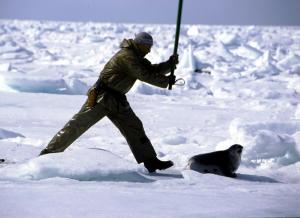|
Issue Date: May 14, 2004
Annual slaughter cannot be defended morally or economically By COLMAN McCARTHY
It’s cruelty time in Canada -- on the ice floes east of Newfoundland and Labrador, to be exact. The annual clubbing, ice-picking or shooting of harp and hooded seals peaks in springtime, with a legalized quota of up to 350,000 kills. Most of the seal pelt bounty is dispatched to international fur and fashion industries, with side profits from meat, oil and the sale of penises to Asian aphrodisiac markets. How many buyers of seal products are likely to reflect on the bloody origins of their goods? Probably few, as the sellers stay mum on the gory details of the Canadian kill. No asking, no telling. Much as the governments of Norway, Japan and Iceland justify their slaughtering of whales for economic and traditional reasons, Canada and its Department of Fisheries and Oceans defend the seal hunt with similar speciousness. The cuddly little creatures, it is said, are really troublemakers. They are ravenous eaters of cod, which means the fishing industry has a depleted catch in the North Atlantic. It’s overlooked that overfishing is the major cause of the scarcity of cod. There is also the balance of nature: Seals actually sustain cod by eating cod predators such as squid and skates. This balance prevailed for millions of years, eons before factory boats and armed humans showed up. No killing of marine mammals -- anywhere -- is larger than the Canadian seal hunt. Nor is any wildlife animal as defenseless as the slow-moving and guileless seal. The Humane Society of the United States, citing Canadian government figures, reports that 96 percent of the 286,238 seals re-ported killed last year were 12 days to 12 weeks old. These are the pups who have yet to learn to swim or eat on their own. In the 1960s and ’70s, Greenpeace and other animal protectionist groups publicized the annual hunt, with the media sending reporters and film crews to catch the sight of Canadians smashing the skulls of seals. But the story became old. Sealing, subsidized by the Canadian government, hung on as public attention faded. This year is different. The Humane Society of the United States, long the strongest voice against the seal hunt, staged a well-attended demonstration in front of the Canadian embassy in Washington March 3. The March issue of National Geographic pictures a harp seal on the cover, with an 18-page story inside. Last July, Sen. Carl Levin, D-Mich., said that “the clubbing of baby seals can’t be defended or justified, and Canada should end it just as we ended the Alaska baby seal massacre 20 years ago.” In addition to raising the moral issue of destroying animal life, Levin argued economics: The subsidized sealing industry isn’t self-sustaining, jobs are provided for only a few laborers and the work is seasonal and part-time. Compared to the massive killing of animals and fowl in the United States -- an estimated 500,000 deaths an hour for food alone, not counting fur or fish farms -- Canada’s cruelty to seals seems paltry. That leads to the question: Why does Canada, a nation whose political enlightenment includes strong environmental standards, a well-run health care system and no taste for military adventurism, allow the seal hunt to go on? This is a Canada that is so image-conscious that it recently went into a dither over a Conan O’Brien wisecrack about the country. With nearly all the world’s major environmental and animal advocacy groups calling for an end to the seal hunt, Canada, by phasing it out, could have another reason to promote itself as a country of decency. Colman McCarthy, a former Washington Post columnist, directs the Center for Teaching Peace in Washington. National Catholic Reporter, May 14, 2004 |
 Cruel seal hunts blacken Canada's image
Cruel seal hunts blacken Canada's image